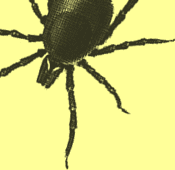

Control of tick populations
Ticks being the chief vector of TBE virus, past efforts to fight TBE were concentrated on the control of tick population in TBE endemic areas. In former Czechoslovakia and USSR, large-scale control measures using Tetrachlorvinphos, DDT, or Hexachlor did not produce the desired effect. As the virus persists not only in ticks but also in wild animals, such measures are of no use in the elimination or even control the disease.
Protective clothes, repellents
As ticks attach to any spot on the host, and from there try to reach an uncovered part of the skin, adequate clothing (solid footwear, socks, close-fitting trousers, smooth fabrics, etc.) may help to make access to the skin more difficult for ticks.
In former Czechoslovakia, forestry workers were given protective clothes impregnated with DDT and were regularly disinfested after work.
Furthermore, a variety of repellents were used, such as diethyl toluamide, indalone, dimethyl carbate, dimethyl phthalate, and benzyl benzoate.
But these preparations afford protection for a few hours only. Moreover, there have been reports from the former USSR of ticks becoming resistant to repellents.
Protective clothes must be completely closed to be really effective, but this may be found intolerable by people spending their leisure time or holidays in endemic areas in the warm season.
Marking of endemic areas by warning signs
In Austria efforts were made to alert the population to the risk of infection in areas endemic for TBE by putting up signs. However, after misuses by local landowners the authorities desisted from this practice.
All these preventive measures directed at ticks have offered only limited protection. It was realised quite early that a vaccine was required for protection from the causative agent itself, the TBE virus.